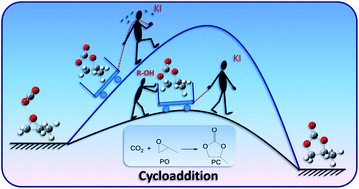Chinese scientists provide a clear picture of the cycloaddition of carbon dioxide (CO2) and epoxides promoted by the KI/hydroxyl catalytic system.

This article is free to access until the 4th September 2012! Click on the link below to find out more…
The catalytic mechanism of KI and the co-catalytic mechanism of hydroxyl substances for cycloaddition of CO2 with propylene oxide, Jun Ma, Jinli Liu, Zhaofu Zhang and Buxing Han, Green Chem., 2012, DOI: 10.1039/C2GC35711A
You may also be interested in this article – free to access for 2 weeks:
One-pot conversion of CO2 and glycerol to value-added products using propylene oxide as the coupling agent, Jun Ma, Jinliang Song, Huizhen Liu, Jinli Liu, Zhaofu Zhang, Tao Jiang, Honglei Fan and Buxing Han, Green Chem., 2012, 14, 1743-1748
Organotin-oxomolybdate coordination polymer as catalyst for synthesis of unsymmetrical organic carbonates, Jinliang Song, Binbin Zhang, Tainbin Wu, Guanying Yang and Buxing Han, Green Chem., 2011, 13, 922-927
Keep up-to-date with the latest content in Green Chemistry by registering for our free table of contents alerts.










